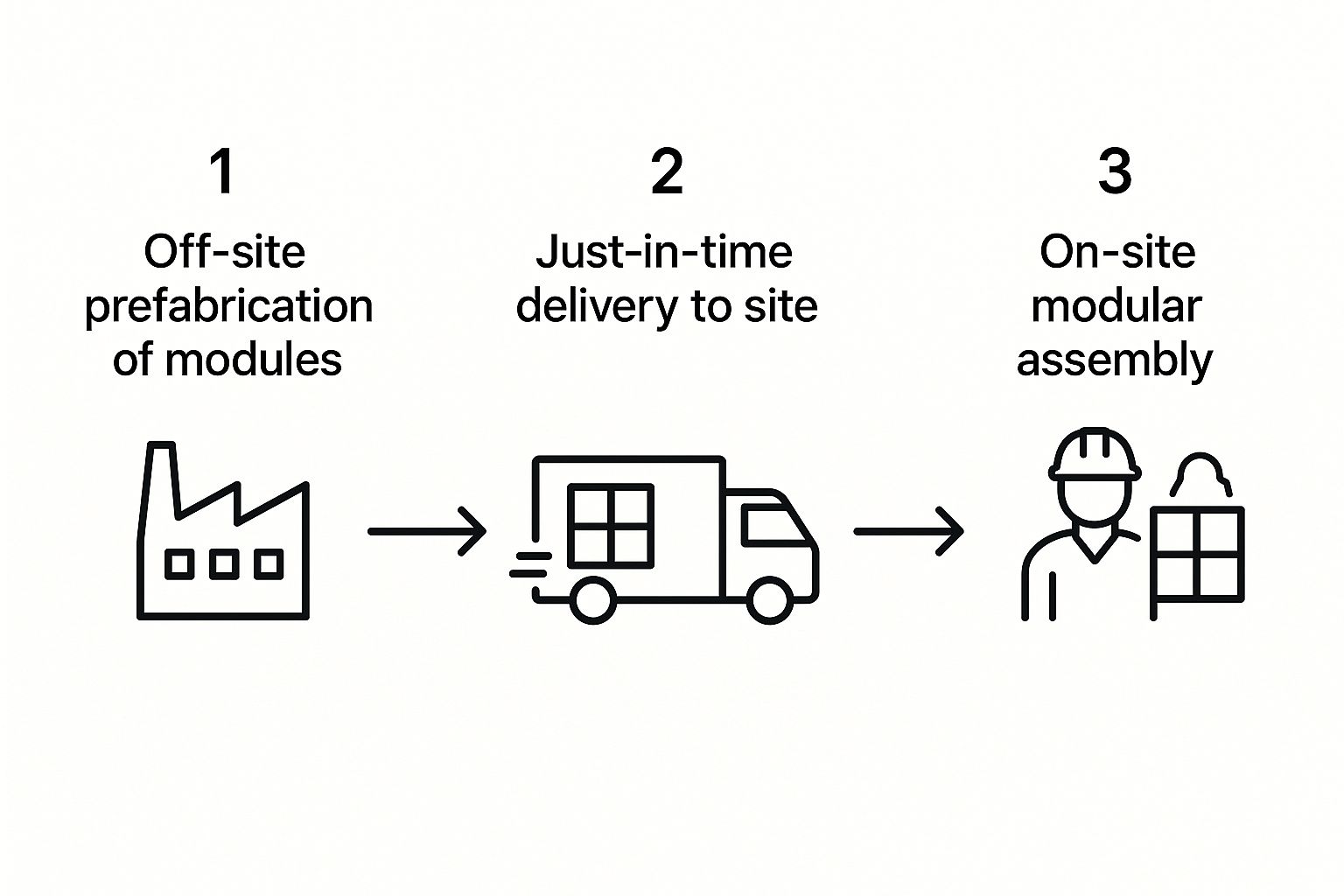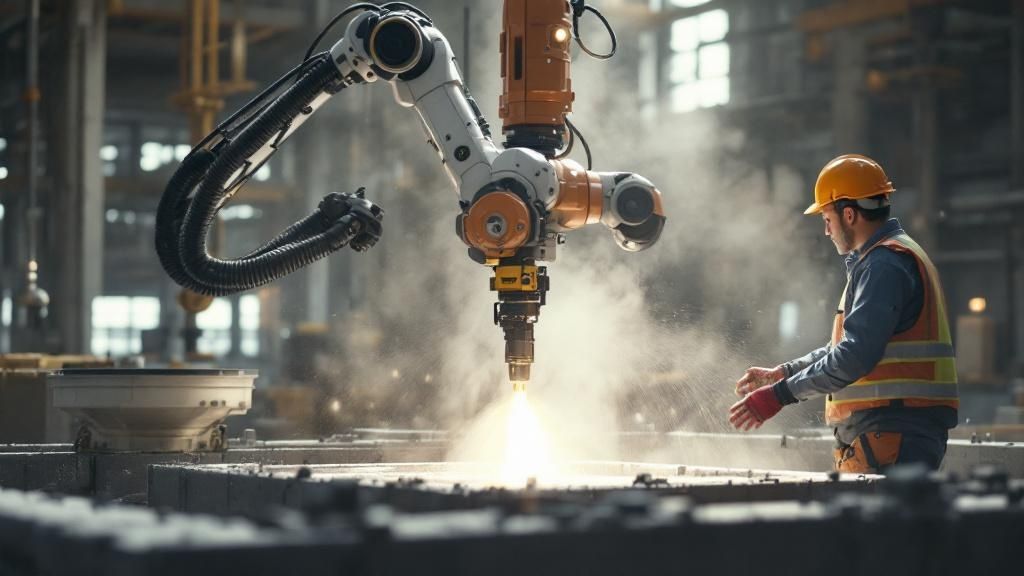If you’re a contractor in the Bay Area, you know the pressure is on. To get ahead—and stay ahead—you can’t just work harder; you have to work smarter.
This means rethinking everything from your initial planning and daily workflows to the tech you use on the job site. It’s all about eliminating waste, tightening up communication, and ensuring your materials and labor are exactly where they need to be, when they need to be there.
Why Improving Construction Productivity is No Longer Optional
For builders, architects, and remodelers in places like Berkeley and Oakland, the job is getting tougher. We're facing a perfect storm: high project demand, a persistent skilled labor shortage, increasingly complex California building codes, and fluctuating material costs.
Frankly, the old ways of managing projects just don’t cut it anymore if you want to stay profitable.
For years, the construction industry has been stuck in a productivity rut. While other sectors have leaped forward in efficiency, construction has barely budged. This isn't just an abstract economic problem—it's a real-world headache that shows up as busted schedules, blown budgets, and stressed-out teams on every job site.
The real issue is the growing gap between what the industry can deliver and what it must deliver. This gap puts immense pressure on every contractor to find smarter, more efficient ways to build.
The Growing Gap Between Demand and Reality
The need for new construction and renovations is massive. According to McKinsey's in-depth analysis, global construction spending is expected to climb dramatically. Yet, our ability to build is held back by labor productivity that has been flat for decades, creating a serious bottleneck.

This global trend hits us hard right here at home. In the San Francisco Bay Area, the pressure is even more intense due to a few local realities:
- Intense Housing Needs: Relentless demand for housing in cities like Oakland and San Francisco means we have to build faster and more efficiently.
- Tough Regulations: Juggling California's Title 24 energy codes and local permit hurdles in cities like Berkeley requires bulletproof planning.
- Sky-High Operating Costs: With labor and material costs among the highest in the country, there’s zero room for waste or inefficiency.
To get a handle on this, we'll walk through essential strategies you can implement right away. The table below gives a quick snapshot of the key areas we're about to cover.
Core Strategies for Boosting Project Efficiency
| Strategy Pillar | Primary Benefit | Key Action for Bay Area Contractors |
|---|---|---|
| Meticulous Planning | Reduces delays and cost overruns | Develop detailed project schedules and confirm material lead times. |
| Lean Workflows | Eliminates waste and improves flow | Implement just-in-time material delivery from a trusted local supplier. |
| Technology Integration | Enhances communication and accuracy | Use project management software for real-time updates from field to office. |
| Workforce Empowerment | Boosts skill and motivation | Provide ongoing training on new building materials and local codes. |
| Performance Tracking | Identifies and corrects bottlenecks | Monitor Key Performance Indicators (KPIs) to measure progress. |
These pillars form the foundation of a more productive, profitable, and less stressful construction business. This guide moves past buzzwords and into practical, field-tested strategies that work for Bay Area pros, from pre-construction to the final punch list.
Start with a Bulletproof Pre-Construction Plan
It's an old saying in this business, but it's true: you win or lose a project long before your crew ever sets foot on site. The pre-construction phase isn't just a box to check; it’s where you save yourself countless hours and thousands of dollars down the road.
This is where you build a roadmap so clear there’s no room for costly assumptions.

The construction industry has been wrestling with efficiency for a long time. An insightful industry analysis highlights that U.S. construction productivity has actually decreased since 2000 while costs have skyrocketed. This is precisely why a bulletproof pre-construction strategy is your best weapon.
Build a Project Roadmap That Leaves Nothing to Chance
The first step is to get more granular than a simple Gantt chart. We’re talking about Advanced Work Packaging (AWP), a system that breaks down massive, complex jobs into small, digestible "work packages."
Each package is a self-contained unit with all the drawings, materials, tools, and labor details needed for one specific piece of the job. This forces you to think through the project sequence at a detailed level, ensuring that when a crew shows up to work, they have everything they need, ready to go.
A Bay Area Remodel Scenario: Why Planning Matters
Picture this: you're running a major home remodel in a Berkeley neighborhood. The client picked beautiful, custom-sized Marvin windows to capture those perfect bay views. You place the order based on a standard lead time, overlooking current supply chain issues.
The windows show up six weeks late, causing a catastrophic domino effect:
- Exterior work grinds to a halt. You can't finish the siding or weatherproofing.
- Interior crews are stuck. Drywall, electrical, and plumbing teams are now sitting on their hands.
- The schedule implodes. You're scrambling to renegotiate timelines with subs who have likely moved on to other jobs.
A solid pre-construction plan would have involved a simple call to a trusted supplier like Truitt & White to confirm the actual lead time, then building the master schedule around that critical date.
Key Takeaway: Your procurement plan isn't separate from your master schedule—it is your master schedule. Treat material lead times with the same gravity you give to permit approvals.
Weave in Material Procurement and Local Realities
Your plan must account for your specific location. For any project in the Bay Area, this means understanding the unique permit processes in cities like Berkeley or Oakland, which often have longer review periods. Bake those administrative delays into your timeline from day one.
Second, material procurement must be a core part of your initial planning. This is where a dependable local supplier is invaluable. For example, when sourcing building supplies in Oakland, having a partner who provides accurate stock levels and reliable delivery windows allows you to run a true just-in-time operation, keeping the site clear and the workflow smooth.
Put Lean Construction Principles into Practice
Adopting a Lean mindset is about declaring war on waste. It’s a practical, on-the-ground approach that shifts your focus from just ticking off tasks to creating a smooth, predictable flow of work. For Bay Area contractors, this means real changes that make a real difference to your bottom line.
The philosophy is built around eliminating the "eight wastes" of construction—subtle but expensive inefficiencies like a crew waiting on a delivery or excess materials cluttering a site.
For example, on a multi-family project in Oakland, instead of having lumber show up weeks early, a Lean approach means you coordinate with a partner like Truitt & White for just-in-time deliveries. This simple change cuts site congestion and reduces the risk of material damage or theft.
The Last Planner System in Action
One of the most powerful Lean tools is the Last Planner® System (LPS). This game-changing process puts the people actually doing the work—your foremen, the "last planners"—in the driver's seat of the schedule.
The system has a few key parts:
- Pull Planning: You work backward from a major milestone, forcing a conversation where every trade identifies what they need from others to get their part done.
- Weekly Work Plans: Every week, teams meet and commit only to tasks that are actually ready to go—no more wishful thinking.
- Daily Huddles: Quick, 15-minute stand-up meetings every morning keep the entire team on the same page and tackle immediate roadblocks.
This system creates a workflow where every step pulls the next one forward, eliminating the frustrating stop-and-start rhythm of most projects.
Standardize Work for Predictable Results
Standardizing repetitive tasks is another powerful Lean tactic. If you're building a residential development with dozens of nearly identical units, why reinvent the wheel every time?
By creating a standard operating procedure for tasks like framing a particular wall section or installing a common window type, you establish a baseline for both quality and speed.
We're not talking about stifling creativity here. By standardizing the process, you're getting rid of the guesswork and creating a predictable rhythm. Your crew can work with more confidence and efficiency.
The image below shows how off-site prefabrication and just-in-time delivery come together to create a streamlined assembly process.

Breaking the project into distinct, manageable phases creates a much more organized and efficient build cycle from start to finish.
Common Construction Wastes and Lean Solutions
To boost productivity, you have to get good at spotting waste on your job sites. The table below highlights common inefficiencies in the Bay Area and the Lean solutions that address them.
| Type of Waste | On-Site Example (Bay Area Context) | Lean Solution |
|---|---|---|
| Waiting | An HVAC crew is ready, but the framers are a day behind schedule. | Last Planner System®: Improves coordination and schedule reliability between trades. |
| Excess Inventory | Pallets of windows for a San Francisco project arrive a month early, cluttering the site. | Just-in-Time (JIT) Delivery: Materials arrive exactly when they are needed for installation. |
| Defects/Rework | Misaligned plumbing fixtures require drywall to be cut open and patched, wasting labor and materials. | Standardized Work: Ensures tasks are done correctly the first time, every time. |
| Unnecessary Motion | Electricians constantly walk across the site to a poorly placed gang box for supplies. | 5S Methodology: Organizes the worksite so tools and materials are stored at the point of use. |
By actively hunting for these types of waste, you can systematically remove friction from your workflow and transform your job sites into well-oiled machines.
Use Accessible Technology to Work Smarter
Thinking that high-tech tools are only for large enterprise firms is an outdated idea. Modern construction tech is about accessible, practical tools that deliver a real return for small and mid-sized contractors. It bridges the gap between the office and the field, eliminating costly rework and providing data for smarter decisions.

Even a modest investment in the right software can dramatically cut down on miscommunication. Swapping paper logs for a mobile app for daily reports creates a searchable, central record of job site progress that anyone on your team can pull up instantly.
Project Management Software: The Digital Hub for Your Job Site
If you’re going to start anywhere, make it project management software. Platforms like Buildertrend or Procore are built for contractors, acting as a single hub for all project communication and documentation.
They help manage:
- Schedules: Create and tweak project timelines that are instantly visible to your crew, subs, and even the client.
- Documents: Store every plan, permit, and change order in one spot, accessible from a phone or tablet.
- Communication: Keep all project-related conversations in one organized thread, ending the chaos of texts and emails for good.
The principles behind good project software are similar to what makes other industries tick. For broader concepts on streamlined communication, this resource on What is Omnichannel Customer Service? offers interesting parallels.
From Blueprints to Digital Models with BIM
For more complex projects, Building Information Modeling (BIM) is a game-changer. BIM creates a rich digital model of the entire structure, with every component—from beams to pipes—existing with all its data attached.
The biggest win here is clash detection. Before pouring a footing, you can run a simulation to see exactly where HVAC ducts might run into electrical conduits. Catching those conflicts digitally saves an incredible amount of money and time that would have been wasted on-site.
Think of it this way: you build the project twice. First on the computer, where mistakes are cheap to fix, and then once on-site, where they definitely are not.
Practical Tech for Bay Area Projects
Let's bring this home to the Bay Area. Drone imagery is no longer a high-tech novelty. On a custom home build in the East Bay hills with tricky terrain, a drone can provide weekly progress photos and topographic data that would be difficult to gather otherwise.
Simple apps also make a huge difference in material management. Instead of guessing when that lumber order will show up, you can track it in real time. This ensures that the durable building materials your contractor needs are on-site when you need them, not sitting around getting warped by weather.
Invest in Your People for Lasting Productivity
All the tech and lean processes in the world are just tools. Your people are what truly drive productivity. Investing in your workforce is the single most durable strategy you have to improve construction productivity and build a business that lasts.
This is especially true in the competitive Bay Area labor market. A team that feels valued and sees a real path for growth is a team that sticks around. That stability alone is a massive advantage, saving you from the constant, costly cycle of hiring and retraining.
Empower Your Crew with Continuous Skill Development
The construction industry never sits still. New materials, advanced building techniques, and evolving California energy codes mean ongoing training is non-negotiable. This doesn't have to mean expensive, off-site seminars.
Integrate training right into your daily operations:
- Targeted Training: When you use a new system, like installing high-performance Andersen windows, get a manufacturer representative to do a training session on-site.
- Cross-Training Programs: Build a more versatile crew by training people in multiple roles. If your go-to equipment operator is out, someone else can step in, preventing the entire job from grinding to a halt.
Investing in skills sends a clear message to your team: you are a valuable, long-term asset to this company. This builds loyalty and expertise, creating a stable, highly capable workforce.
A well-supported team is a major business asset. To learn more, check out our guide on customer service excellence for professional builders.
A Strong Safety Culture Is a Productive Culture
Nothing kills productivity faster than an accident. A single serious incident can trigger work stoppages, Cal/OSHA investigations, and a devastating blow to team morale. A robust safety culture is a direct driver of efficiency.
When safety is a core value, crews work with more confidence. Here in the Bay Area, that means being rigorously compliant with Cal/OSHA standards, which are some of the toughest in the nation.
Holding regular "toolbox talks" and reinforcing safety protocols daily are simple but powerful habits. A safe site is an organized, efficient site where work just flows better. This focus also keeps your team consistently on the job, and implementing effective absence management strategies can further solidify your crew's output.
Measure Performance to Drive Continuous Improvement
You can't improve what you don't measure. After you’ve rethought your planning, workflows, and tech, the final piece is tracking your performance. This isn't just about finishing on time and on budget; it’s about digging into the data to find real bottlenecks and continuously getting better.
To move the needle on productivity, you need to get granular with specific Key Performance Indicators (KPIs) that tell the story of your day-to-day operations.
Key Metrics That Matter for Bay Area Contractors
You don’t need a hundred different metrics. A few targeted ones can tell you almost everything you need to know, helping you spot trouble early and make smarter decisions backed by real numbers.
- Planned Percent Complete (PPC): A core part of the Last Planner® System, PPC tracks how many of your weekly planned tasks actually got done. Consistently hitting over 80% is a great sign that your schedules are realistic.
- Labor Efficiency Rates: This measures your crew’s output against the hours they put in. It helps you see how different tasks, tools, or site conditions affect performance.
- Number of RFIs (Requests for Information): A sudden spike in RFIs is a red flag, usually pointing to incomplete plans or a breakdown in communication.
Good Key Performance Indicators (KPIs) for employees are also critical for showing how each person’s effort contributes to the bigger picture.
The Power of Post-Project Reviews
Once the project is handed over, the real learning begins. A structured post-project review—or "post-mortem"—is one of the most valuable things you can do. This isn't about pointing fingers; it's about capturing lessons so you don't make the same expensive mistakes twice.
Get your key people in a room and have a frank discussion using a few simple questions:
- Where did we absolutely nail it on this project?
- What were the biggest curveballs we didn't see coming?
- Where did we leak the most time or money?
- How was the service from our material suppliers and partners?
Key Takeaway: A disciplined post-project review transforms past experiences into a future competitive edge. The goal is open dialogue where your team can honestly assess what happened and collaboratively find better ways to build.
This final step closes the loop, turning raw data and experience into an engine for growth. Partnering with a supplier who understands the demands of your jobs is crucial. Reliable access to quality building materials in the San Francisco Bay Area with lead times you can count on is a cornerstone of any solid productivity strategy.
Start by implementing one new strategy, measure its impact, and build on that success. For expert advice on materials and project planning that supports your productivity goals, visit our Berkeley showroom or connect with our team today.
Frequently Asked Questions About Improving Construction Productivity
What is the single biggest factor affecting construction productivity?
Inadequate pre-construction planning is the biggest culprit. When work isn't properly sequenced, material lead times aren't confirmed, and trades aren't coordinated before you break ground, you create a recipe for delays, rework, and budget overruns.
Can small Bay Area contractors really use Lean Construction methods?
Absolutely. Lean principles scale down perfectly for small and mid-sized contractors in Oakland, Berkeley, and across the Bay Area. Simple changes like holding daily huddles, keeping the job site organized, and coordinating just-in-time material deliveries with your supplier can significantly boost efficiency without a large upfront investment.
What technology offers the best ROI for a local builder?
For most small to mid-sized builders, project management software like Procore or Buildertrend offers the best return. It centralizes communication, scheduling, and documents in one accessible place, which cuts down on miscommunication between the office and the field and prevents costly mistakes.
How does a reliable building material supplier improve productivity?
A great supplier is a strategic partner who improves productivity by providing accurate lead times for critical items like windows and doors, allowing you to build a realistic project schedule. They also coordinate deliveries to match your workflow, preventing site clutter and ensuring you have the right materials, in the right place, at the right time.
Where should I start if I want to improve my team's efficiency?
Start with daily huddles. This simple, 15-minute meeting each morning is one of the fastest ways to improve alignment and on-site productivity. Use it to run through the day's plan, identify potential roadblocks, and confirm everyone has what they need to get the job done right.
For more answers to common questions, please visit our main frequently asked questions page.









